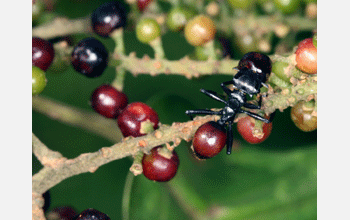Multimedia Gallery
Ant Infected With Nematode Eggs (Image 3)
Ant Infected With Nematode Eggs (Image 3)
When the tropical ant Cephalotes atratus is infected with the parasitic nematode Myrmeconema neotropicum (or roundworm), its normally black abdomen turns red, resembling the many red berries in the tropical forest canopy.
Researchers believe this change is intended to dupe birds into eating the gasters, which are full of nematode eggs. The eggs are transported to new ant colonies via the bird's feces, which are frequently collected by this species of ant. The research is published in the April 2008 issue of The American Naturalist. The discovery was made by Robert Dudley, a professor of integrative biology at the University of California, Berkeley, and colleagues. To learn more about this research, see UC press release "Ant Parasite Turns Host Into Ripe Berry, Biologists Discover.". (Date of Image: June 2007) [Image 3 of 3 related images. Back to Image 1.]
Credit: Steve Yanoviak, University of Arkansas at Little Rock
Images and other media in the National Science Foundation Multimedia Gallery are available for use in print and electronic material by NSF employees, members of the media, university staff, teachers and the general public. All media in the gallery are intended for personal, educational and nonprofit/non-commercial use only.
Images credited to the National Science Foundation, a federal agency, are in the public domain. The images were created by employees of the United States Government as part of their official duties or prepared by contractors as "works for hire" for NSF. You may freely use NSF-credited images and, at your discretion, credit NSF with a "Courtesy: National Science Foundation" notation.
Additional information about general usage can be found in Conditions.
Also Available:
Download the high-resolution JPG version of the image. (724 KB)
Use your mouse to right-click (Mac users may need to Ctrl-click) the link above and choose the option that will save the file or target to your computer.

